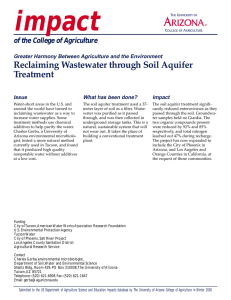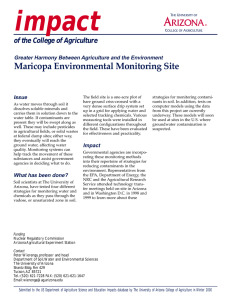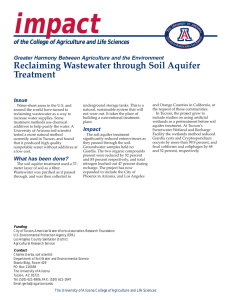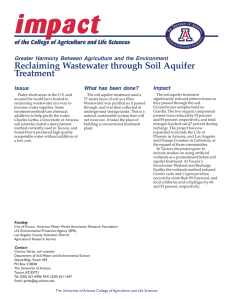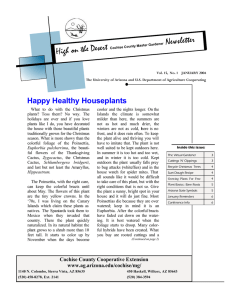Newsletter High on the Desert
advertisement
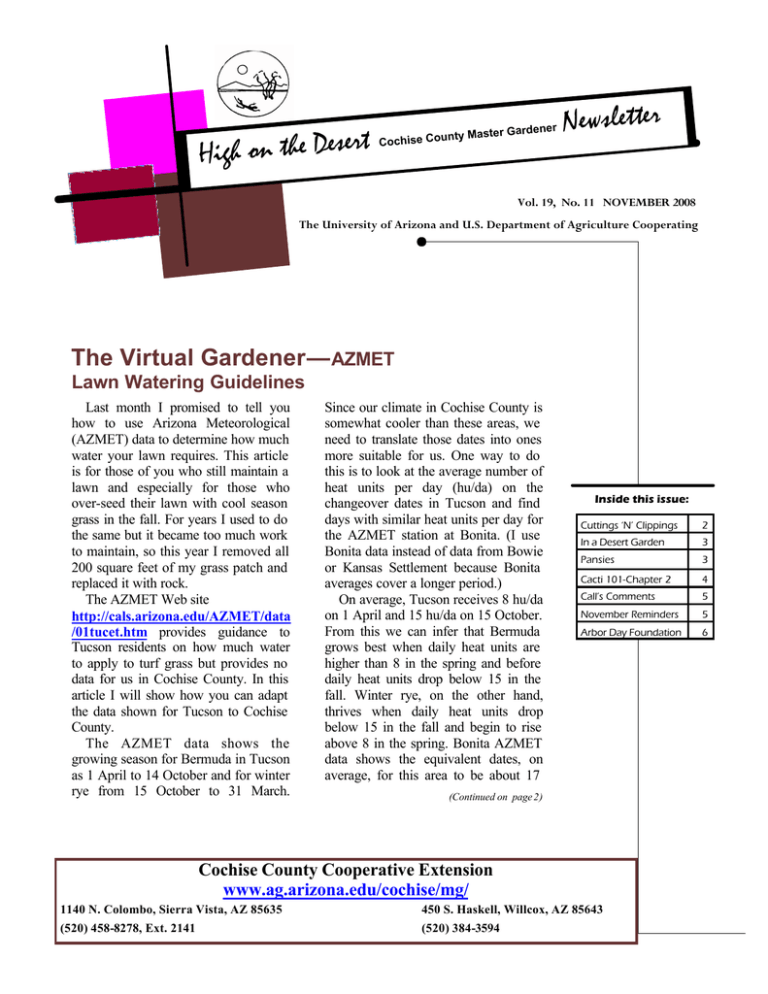
High on the Desert dener Master Gar hise County Coc Newsletter Vol. 19, No. 11 NOVEMBER 2008 The University of Arizona and U.S. Department of Agriculture Cooperating The Virtual Gardener— AZMET Lawn Watering Guidelines Last month I promised to tell you how to use Arizona Meteorological (AZMET) data to determine how much water your lawn requires. This article is for those of you who still maintain a lawn and especially for those who over-seed their lawn with cool season grass in the fall. For years I used to do the same but it became too much work to maintain, so this year I removed all 200 square feet of my grass patch and replaced it with rock. The AZMET Web site http://cals.arizona.edu/AZMET/data /01tucet.htm provides guidance to Tucson residents on how much water to apply to turf grass but provides no data for us in Cochise County. In this article I will show how you can adapt the data shown for Tucson to Cochise County. The AZMET data shows the growing season for Bermuda in Tucson as 1 April to 14 October and for winter rye from 15 October to 31 March. Since our climate in Cochise County is somewhat cooler than these areas, we need to translate those dates into ones more suitable for us. One way to do this is to look at the average number of heat units per day (hu/da) on the changeover dates in Tucson and find days with similar heat units per day for the AZMET station at Bonita. (I use Bonita data instead of data from Bowie or Kansas Settlement because Bonita averages cover a longer period.) On average, Tucson receives 8 hu/da on 1 April and 15 hu/da on 15 October. From this we can infer that Bermuda grows best when daily heat units are higher than 8 in the spring and before daily heat units drop below 15 in the fall. Winter rye, on the other hand, thrives when daily heat units drop below 15 in the fall and begin to rise above 8 in the spring. Bonita AZMET data shows the equivalent dates, on average, for this area to be about 17 Inside this issue: Cuttings ‘N’ Clippings 2 In a Desert Garden 3 Pansies 3 Cacti 101-Chapter 2 4 Call’s Comments 5 November Reminders 5 Arbor Day Foundation 6 (Continued on page 2) Cochise County Cooperative Extension www.ag.arizona.edu/cochise/mg/ 1140 N. Colombo, Sierra Vista, AZ 85635 450 S. Haskell, Willcox, AZ 85643 (520) 458-8278, Ext. 2141 (520) 384-3594 PAGE 2 (Continued from page 1) April in the spring and 19 September in the fall. When using the AZMET data to determine how much water to apply to your lawn, you first must determine what level of appearance you want to maintain. The two levels shown are AQ (acceptable quality) and HQ (high quality). Acceptable quality is appropriate for home lawns. The actual water requirements of plants depend on a number of factors, including temperature, humidity, wind, and many others. The effects of all these factors are bundled together into a single number that AZMET refers to as Standardized Reference Evapotranspiration, ETos for short. In order to translate this into the actual amount (in inches) of water required by a given type of plant, the ETos value must be multiplied by a fudge factor called a crop coefficient. The crop coefficient for acceptable quality appearance for Bermuda is .73 and for winter rye is .70. To determine how much irrigation is required by your lawn, you can subtract any precipitation that falls during the day from the required amount calculated from ET. Although the crop coefficients shown for Tucson are applicable in Cochise County, the daily ETos values are not. To get local values we must look at data from Bonita, Bowie, or Kansas Settlement. To find these data go to http://cals.arizona.edu/AZMET/ current.htm and select Daily for the location of your choice. Two different values for ET are shown, one for AZMET Reference ET and the other for Standard Reference ETos. The two values are calculated using basically the same formulas but the AZMET uses a different measurement for solar radiation. To be consistent with the turf watering guide for Tucson, use the standard reference value. To show you how this works, lets use Bonita data http://cals.arizona.edu/AZMET/ data/09eh.txt to determine how much water winter rye grass requires. On 25 October this year, the data showed a Standard Reference ET value of .15 and no precipitation for the day. Using the crop coefficient of 0.70 for winter rye we calculate (.15 X .70) the water requirement to be 0.10 inches for the day. If your irrigation schedule calls for watering your lawn every three days, calculate the water requirements for each of the three days and add them together to determine how much water to apply. For additional information on determining water requirements for your lawn check out the Water Wise Web site at http://ag.arizona.edu/cochise/wat erwise/checklist.pdf, and for more general information on winter lawn care, check out Dave Kopec’s article at http://cals.arizona.edu/turf/tips1 298.html. Until next time, happy surfing. Gary A. Gruenhagen, Master Gardener virtualgardener@cox.net Cuttings ‘N’ Clippings T The next CCMGA meeting is 5:00 p.m. Thursday, November 6 at the University of Arizona South Campus Public Meeting Room. Ted Mouras will represent the Friends of the San Pedro. T The next FREE WaterWise workshop will be held at the University of Arizona South Campus Public Meeting Room on Saturday, November 1, from 9:00 to 11:00 a.m. The presentation, Septic Care, will be given by Dawn Long, owner of American Septic Service. There will not be a workshop in December. T The 16th High Desert Gardening & Landscaping Conference will be held at the Windemere Hotel & Conference Center on February 12 & 13, 2009. Mark your calendar now and plan to attend this educational experience. Please note: there will not be an increase in the registration fee from 2008! Robert E. Call Extension Agent, Horticulture Carolyn Gruenhagen Editor PAGE 3 In a Desert Garden Southwestern Coral Bean– Erythrina flabelliformis, Pea Family The very first “High on the Desert” Conference I attended was in 1997. After this event I took the Master Gardeners course. My husband and I had just moved to Sierra Vista and we had our house built in that year. I had gardened in extreme climates like Alaska and West Virginia, but I was not familiar with the High Desert and its challenges. Then one day I read in the newspaper about the conference and thought it is time to educate myself. I enjoyed the Conference and the classes so much that I am still active in this program. I am proud to be a Master Gardener and to belong to this group of dedicated people. At that conference I purchased Coral Bean seeds from one of the vendors. My husband was a rock hound and we spent many days exploring the mountains here in SE Arizona. My husband was looking for interesting rocks and I explored the flora and fauna. On one of those trips, I came across the Coral Bean plants. They are really unusual plants with very showy coral red flowers that appear on barren stems; the leaves grow later depending on humidity. Looking at these tubular flowers, one just knows that the hummingbirds will love them. The Coral Beans like to grow in depressions on dry rocky slopes at 3,000’ to 5,000’ elevations. I just had to grow this plant in my new garden. Of course it is impossible to find this plant in the local nurseries. I was excited to find the seeds at the conference. The seeds are lovely, quite big and bright red. They are used in Mexican Jewelry, but they are very poi- Coral Bean blossom garden here in Sierra Vista, the plants that grew there were quite a bit taller than mine but not 15’ tall either. I came to the conclusion that the plants might get more moisture in the mountains than in my garden and this year I will give them a little extra water during the winter if it is a dry one. The plant is deciduous and will only show the barren stems during the winter months. Angel Rutherford, Master Gardener sonous. I was told by the lady who sold me the seeds to scar the hard shells and then plant them. I did just that. I planted them on a slope in my front yard and covered them with gravel. Gravel is a very good seed germinator as it gives up moisture in the morning and protects the seeds. I planted my seeds and I waited, and sure enough during the monsoon the seeds sprouted and the plant emerged. I did not take any special care of this plant; just let nature take its course. Every year the plant puts out the beautiful almost heart shaped, bluish green leaves, but never any flowers. I did some research and read that the plant will need several years to be adult enough to flower, but ten years? This year in late spring I looked into the corner where the plant was growing and to my joy, I noticed one beautiful coral red flower. I was very happy that all my patience paid off. In the book Plants of Arizona, the plant is described as a shrub or small tree to 15’ tall. My plant so far has grown only to 2’ tall, with the flower stalk being a little taller. On my many trips into the mountains, I have never come across one that was 15’ tall, but at a visit of a wonderful cactus Pansies Pansies (Viola X wittrockiana) are one of the few plants that can be counted on to provide winter color here in the High Desert. Why we ever chose them to provide the cognomen for weak and gutless people I’ll never know. Despite their pretty faces, they are tough little hombres that thrive in cold weather. On a cold morning their leaves and flowers will actually freeze, but by afternoon they’ll be back holding their bright flowers to the sun. Besides looking good, some people think pansies taste good too. The flowers can be used in salads or crystallized and used as decorations on cakes. The name “pansy” is derived from the French pensée, meaning “thought” and a gift of pansies means, “I’m thinking of you.” If you would like to find out more about pansies, point your browser at: http://doit101.com/Gardening/ pansies.html Gary A. Gruenhagen, Master Gardener virtualgardener@cox.net PAGE 4 Cacti 101: C h a p t e r 2—S p i n e l e s s B u t N o t H a r m l e s s In Chapter 1 we discussed propagation of cacti from cuttings. An update of the author’s latest attempt at propagating from cuttings may help readers establish realistic goals when using this approach. Four months ago sixteen cuttings were planted in a new area of the garden. The soil was fairly uniform throughout the area. Today we find nine of these cuttings growing nicely with two or more new pads. Three of the cuttings appear healthy but have yet to show any new growth. The remaining four cuttings are doing poorly and may not survive. Spines and Glochids The Oxford American Dictionary defines spine as “one of the sharp needlelike projections on certain plants such as cacti.” Glochids are also found on cacti. They tend to grow as tufts of innocent looking hair-like projections. Do not be fooled. Spines can inflict painful wounds but usually only a few find their way into our flesh. They are also easily seen and removed. Glochids are a completely different problem. If you come in contact with a tuft of glochids you will often leave the scene with tens or even hundreds of the little devils imbedded in your skin. They are less painful than an encounter with a cacti spine but there ends the good news. Glochids are often very difficult to see and are very irritating. You can avoid most encounters with both spines and glochids by using tongs or other handling devices. In Chapter 1 we recommended misting cacti with glochids be- fore handling as a means of preventing glochids from becoming airborne. Opuntia ficus-indica One of the most widely distributed cacti in the world is the Opuntia ficus-indica. This species is found on every continent except Antarctica. There is evidence that this cactus was used as a human food source as long as 9,000 years ago. O. Ficus-indica is often called the spineless prickly pear. This common name is somewhat of a misnomer as O. ficus-indica do have the occasional spine and can also have small clumps of glochids as seen in Figure 1. lowed by roundish fruits, called tunas, which ripen from yellow to red. Figure 2. Figure 2 These are the fruits that you may see in grocery stores. They have a taste similar to a juicy sweet watermelon. In fact, both the fruits and the pads, or nopales, are edible. If you wish to sample O. ficus-indica good recipes can be found on several web sites including www.succulent -plant. com/crecipe.html. Unfortunately other critters also find O. ficusindica quite tasty. In fact javelinas consider O. ficus-indica a prime food source and will eat young cacti right down to the ground. Figure 1 While not a Cochise County native this cacti is so widely grown locally it qualifies as naturalized citizen of the county. This is a huge cacti and care should be taken in selecting the planting site for O. ficus-indica. The mature individual cactus can reach 15 feet in height and as much as 10 feet across. The flat oval pads grow from woody trunks. This is a cactus best suited for open areas away from structures or as part of a barrier. O. ficus-indica bears three to five-inch yellow or orange flowers in late spring or summer. The blossoms are fol- Figure 3 Figure 3 shows some javelina damage. Many growers who do not wish to harvest the fruits as a food source remove them before they ripen as they are a very attractive food source for rodents. Doug Templeman, Master Gardener PAGE 5 Call’s Classic Comments Wives Tales and Snake Oils Myth #1: Soil structure and chemistry can be changed with amendments. Soil is huge; it is under our feet everywhere. The weight of one cubic foot of soil is from 80 to 120 pounds depending on the soil type. Many western desert soils have from one to ten percent free lime or calcium carbonate. In our desert soils we have alkaline soil pH’s. This is because of the calcium carbonate content of the soil. It is not leached through the soil because of our limited rainfall. Back in the East and Midwest the high rainfall amounts removes the calcium by leaching and the result is acid soils. Assuming a cubic foot of soil weighs one hundred pounds and has a 1% calcium carbonate content then there would be one pound of calcium carbonate present. It takes one pound of sulfuric acid or its equivalent to neutralize one pound of calcium carbonate. Therefore, to decrease soil pH from alkaline to neutral or acid it would require equal mixing of one pound or equivalent of sulfuric acid throughout the cubic foot of soil. If the soil had 10% calcium carbonate then ten pounds of sulfuric acid or its equivalent would be needed to neutralize the soil. This is not cost effective to do and is not going to happen. We need to learn to work with the soil we have on our property. Myth #2: Chemical fertilizers harm the soil and the organisms in it. The soil is a dynamic, living world of microscopic bacteria, fungi, nematodes, and other organisms which are not static but constantly changing. When anything is added to the soil there is a reaction in terms of soil chemistry and organisms. “For every action there is an opposite and equal reaction” applies to the soil. As a fertilizer is added to the soil, whether from a “chemical” or “organic” source, the population and ratio or organisms changes. If the fertilizer is high in nitratenitrogen the bacteria and fungi that consume it will increase in population, perhaps pushing out of balance other organisms for a while. When the nitrate-nitrogen is consumed by soil organisms and/or plants the soil returns to pre-nitrate-nitrogen “normal” and the population of organisms returns to “normal.” “Organic” forms of fertilizer have the same effect on the soil, however they normally break down more slowly. “Organic” sources of nitrogen, for example, have to be broken down by soil organisms to nitratenitrogen before they can be used by plants for growth. Plants can use only inorganic sources of nitrogen. Just because something comes from a “natural” source does not mean that it is better or worse than “conventional” sources. Some of the most toxic compounds known to man come from “natural” sources, i.e., botulin toxin, nicotine, and the venom of a South American sea snake. Bagged fertilizers are mined in the cases of phosphorous and potassium. Nitrate and ammonium nitrogen comes from natural gas and air (which is 78% nitrogen gas) that are combined and processed under high temperatures and pressure. These are all natural products combined to make an “artificial” product. November Reminders Myth #3: Organically grown food does not use pesticides. “Organically grown food is food grown without pesticides, grown without artificial fertilizer, grown in soil whose humus content is increased by the additions of organic matter, grown in soil where minimal content is increased with applications of natural mineral fertilizers, has not been treated with preservatives, hormones, antibiotics, etc.” —Robert Rodale ♦ A good time to install a drip system ♦ Replace summer mulch with fresh ♦ Start a winter herb garden ♦ Protect plants from frost (Call the Extension Office for a copy of the bulletin Frost and Frost Protection) (Continued on back page ) Issued in furtherance of Cooperative Extension work, acts of May 8 and June 30, 1914, in cooperation with the United States Department of Agriculture, James A. Christenson, Director, Cooperative Extension, College of Agriculture and Life Sciences, The University of Arizona and Arizona Counties cooperating. The University of Arizona is an equal opportunity, affirmative action institution. The University does not discriminate on the basis of race, color, religion, sex, national origin, age, disability, veteran status, or sexual orientation in its programs and activities. The information given herein is supplied with the understanding that no discrimination is intended and no endorsement by Cooperative Extension is implied. Any products, services, or organizations that are mentioned, shown, or indirectly implied in this publication do not imply endorsement by the University of Arizona. (Continued from page 5) This quotation from Mr. Rodale, whose father, J.I. Rodale, began Organic Gardening Magazine, states that “organic” growing does not use pesticides. Webster’s New Colligate Dictionary defines a pesticide as “an agent used to destroy something that pesters or annoys.” What are rotenone, pyrethrum, or insecticidal soap used for? To kill pests! I believe that Friend Sykes (1888-1965), an English estate owner, had a better perspective on “organic” growing. He said, “Organic methods are not, therefore, a matter of avoiding the use of artificials; they require that the cultivator should encourage the fertility which lies, actually or potentially, in the soil itself, and should regard the soil not as inert matter but as a living organism.” To be continued next month . . . Robert E. Call Extension Agent, Horticulture (Note: Originally given as a presentation to the Southwestern Low Desert Landscaping and Gardening Conference in Phoenix in August 1995. Reprinted from the November & December 1995 Cochise County Master Gardener Newsletter. Rob Call is currently on a University of Arizona sabbatical.) 9 Things You Should Know About Trees #1 - Don't Top Trees! #2 - 1/3 and 1/4 Rules of Pruning #3 - How to Make a Pruning Cut #4 - The Value of Mulch #5 - Where Roots Really Grow #6 - Girdling Kills Trees #7 - How to Plant a Containerized Tree #8 - How to Plant a Bare-root Tree #9 - Your Street Trees May Be City Trees The cultivation of trees is the cultivation of the good, the beautiful, and the ennobling in man. —J. Sterling Morton This and much more information on trees is available from the National Arbor Day web site http://www.arborday.org/trees/ nineThings.cfm
